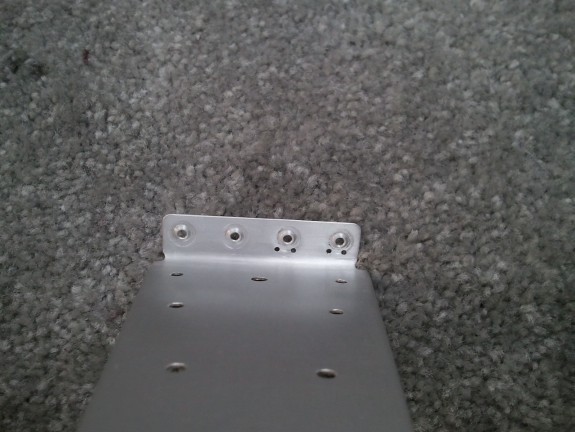I Did it Again! Grrr….
The instructions say in order to join the right elevator Spar (E-702) to the root rib (E-709) you have to use flush (AN426) rivets so that the elevator horn (WD-605-R-1) can lay flat against the spar at the joint. To do this, they say that you need to countersink the forward face of the E-702 spar for the flush heads for the four holes that join it to the E-709 rib. Another option that Van’s says is OK is to dimple the E-702 spar and the E-709 flange instead. Really, these 4 rivets are simply nailing the flange of the E-709 rib to the E-702 spar but most of the strength is handled in the Elevator Horn that also rivets these two parts together at the corner.
With that said, I chose to dimple these over the countersink. After all, the dimple keeps the full thickness of the parts and should be stronger. Dimpling the spar was a matter of putting the dies in the DRDT-2 and smashing away. The rib flange is another story. It is bent past 90° and thus makes it tough to get the dies on the back side much like the trailing edges of the skins for say the elevators and ribs. Typically, I would grab my pop rivet dies here and squeeze away. However, I had just purchased a tool that I thought…heck, that should work here.
Here is the tool. Basically, it is a female die for a AN426AD3 rivet set in a bar so you can reach in to close spaces. You then take a rivet set with a hole in the end that will accept the male die and grab the rivet gun. Then you line up the pilot of the male with the hole and the female die. A few taps from the rivet gun and you should have a nice dimple in a tight spot. Sounds easy enough right?
Remember when I posted about my shop air supply setup? Well, it turns out that my brilliant setup bit me. Part of the setup to use the tool above is setting the pressure right on the regulator for the rivet gun. The various pneumatic tools I have all use different PSI settings. I ran over to the regulator, excited to try my new tool, and dialed down the pressure to about 30 psi. I ran back over to the bench, lined up the pilot, hole, and die. I took a deep breath and squeezed the trigger. Almost immediately I thought…”Man, this thing is hitting really hard!” At that point it was too late. I had ruined the flange of the rib. It hit sooo hard, it cracked the rib near the radius bend. I immediately slapped the forehead and reprimanded myself for again not testing a tool on scrap first.
Well…that part was scrap now anyways…so let’s at least get it right for the future. I could have just made a doubler out of scrap and perhaps made a scab flange and salvaged the rib, but empennage parts are cheap and I needed to place an order for some stuff with Vans anyway. So I went back over to the regulator and dialed it way down and tried it again on the next hole. Funny thing…it hit just as hard again. I was starting to thing something was wrong with the regulator or my rivet gun. I tried turning down the flow at the gun and hit the third hole. Some improvement, but still hard hitting.
Tried another setting change and still…this gun is hitting really hard. The regulator was way down on PSI, the flow was down…what is going on? I grabbed some scrap and drilled and deburred some #40 holes and kept trying with no luck. In frustration, I looked again over to the wall and then realized my error. My hose was still plugged into the Tank Pressure Outlet. I was running 135 PSI through the gun. In all the time I was setting the regulator, I never noticed that I was plugged into the unregulated side of my setup.
Immediately, I began to wonder…did I just ruin my rivet gun? Did I bend up some dies…what else? Once I moved my hose over to the correct outlet, dialed up the regulator and flow, the remaining tests proved to work. The tool works great…if you are set up right. Doh!
So…I needed to order up a new E-709. That killed my chances of getting the right elevator complete over the weekend. I decided to try my skill of stop drilling the cracks to make the most of the mistake. It turned out good. I still had things I could do over the weekend, so I set everything aside and called it good for the night.
NEVER TEST A NEW TOOL ON AN ACTUAL PART!!!











